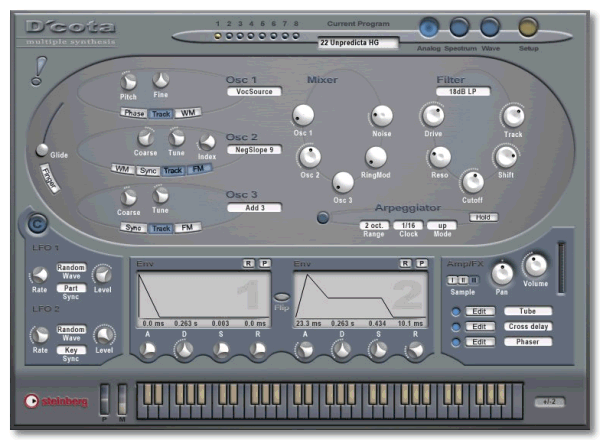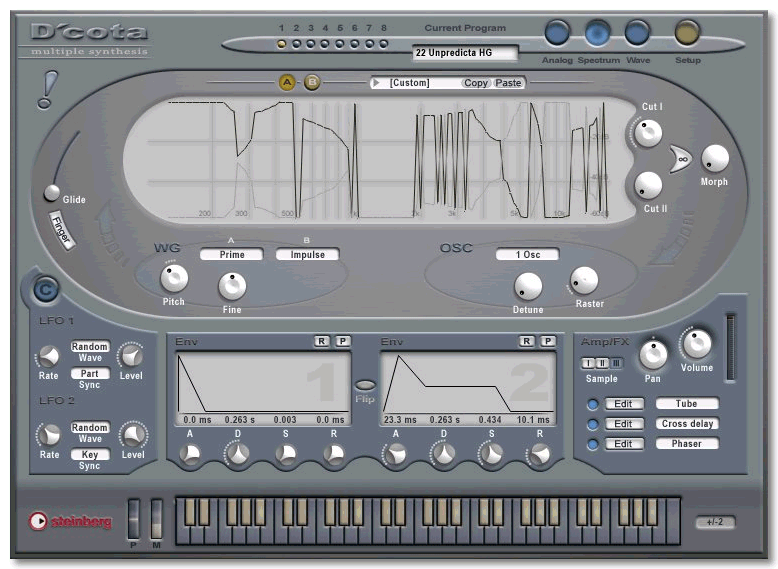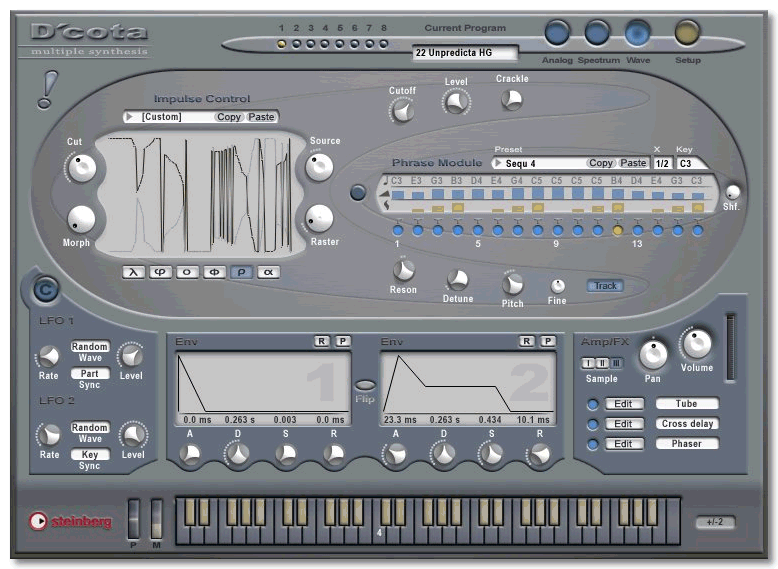D'cota

This article was first written for Keyboards / Home Studio magazine. It is published here with their kind permission, thanks ,o)
Computer assisted music doesn't stop with proposing to us some virtual instruments being all powerful one another, each other. It's getting thus extremely difficult for the editors to keep up with competition, the more so as you can find easily some VST Instruments in freeware very well designed, powerful and... free ! But Steinberg don't give up and are presenting D'cota. Let's see what makes the difference.
D'cota is a virtual synth of 128 polyphony voices, 8
multitimbral "parts", 4 stereo Audio outputs proposing 3 different types of synthesis :
Analog, Spectrum and Wave. We will talk about this later. It is available in VST format
for PC, Mac OS 9 and MAC OS X.
The installation is unrolling without any problem, you will just be asked
where to put the plugin. Nothing else.
As usual at Steinberg, the interface is nice although it is sober. But the
choice of the black serigraphy on dark gray background doesn't make it always readable.
The software is released with 3 soundbanks which allow to use it right
now without having a look to the manual (on paper and in French !). At first
listening, you realize that D'cota's vocation is not the simulation
of acoustic instruments, but is to be able to propose some wealthy and original analogic sounds. Immediately after the opening, I notice two things :
- My Pentium 3 1 GHz is getting old and certain sounds use 50 % of CPU with some peaks at 70 when attacking notes !
- In Cubase SX, it frequentely happens that once D'cota's window is active, anymore key makes it possible to command SX and this, whatever is the adjustment that you chose for D'cota (window always in foreground or not). It is probably a youth's mistake but it is rather embarrassing.
If you can work without the manual regarding the basic use, it is an other story as soon as you decide to build your own sounds. Indeed, D'cota proposes some various parameters, often interacting between them and the reading of the manual seems to be essential to me if you don't want to proceed differently from chance. Let's note besides Steinberg's educative effort who propose bluntly some little exercices to learn how to build a sound. Excellent idea !
D'cota proposes thus 3 distinct synthesis modes.
Analog. You've got here pure substractive synthesis with all that is necessary to
make it sound : 3 oscillators (with FM possibility), 1 powerful and complete filter, an arpegiator, some ring modulation etc. Nothing really original,
would you tell me. Where D'cota is distinguished itself, it is in the choice of waveforms
available for each oscillator. Besides the eternal Square, Triangle,
Sinus and sawtooth, we find Formant, Vocal, Partial, ResoPulse and
Slope. Not enough place to detail them all, but you must know that each type of
waveform allows to generate some original tones which, being combinated ones to others,
give access to a very large, and why not infinite, sound range.

Spectrum. It is getting a little bit complicated ! 1 to 6 oscillateurs produce two waveforms, each one going then through their respective spectral filter. Those filters determine the frequency response and are drawn with the mouse. It's not all ! The "Morph" control makes it possible to mix the two filters' output. The sounds came by this module are impressive but particularly greedy of CPU.

Wave. It's a derived part from the Spectrum synthesis. 1 oscillator generates two waveforms which go through 2 spectral filters. The signal presents itself then in front of 3 comb filters "plugged" in parallel with re-injection (some FeedBack, so !). If you add to all of this a mini 16-step sequencer (a programmable arpegiator in fact), I let you imagine all the possibilities ! This module is particularly comfortable with percussive sounds, but especially with background notes which filters change in time.

Best is to say that those 3 synthetisers offer a nice sound range where everyone
will dip some new sounds and, why not, inspiration...
I can hear you from here dreaming about the possibility to merge the three synthesis systems
to obtain some never seen, never heard. I will make you get down
quickly from your little cloud, it is not possible...
We saw here the own parameters to each synth but we have still left to
have a look to those which are common to them, and here again, there are much to tell !
We have at our disposal two LFOs (which must be assigned to a parameter before
being able to be used, see below). Nothing really original, but there is all what we need.
Then come 4 envelopes made of ADSR type. If the first one is sent by default
to the main volume, they can be used anyway for controlling anything (see below, bis !).
If you appraise that your sound didn't undergo yet all the outrages, it still
remains to you 3 ways to carve it : the effects ! D'cota is furnished with a
distorsion, a delay and a chorus ! The available parameters for each
effect are typically those you usually wish to have about this sort of processing...
The icing on the cake : there's a button which is useful for changing
D'cota's adjustments in a hazardous way ! Steinberg have just inventing the
substractive "art of hazard" with spectral comb filters ! It's a little bit the raffle
of sonorous synthesis, the jewel is rare among the frantic results
generated most of the time by this function. But it is funny !
Here's a really interesting point in D'cota : the disconcerted easiness
you have to make each parameter being controlled by many sources, Midi controllers
of course, but also many other D'cota's elements. Open the Controllers bar,
choose the source (After Touch, Modulation Wheel, "Key
Track", Velocity, Envelope, LFO) and click then on the parameter which will be controlled
by the source. That's all ! No, in fact, that's not all ! D'cota
accepts also to be driven by an external Midi source. Here again, the
"Midi Learn" function available under the right click of each button will make the
setting easier.
If those methods wouldn't ever meet the case to you, it is evident that D'cota is
fully automaticable and that it is thus easy for example to draw a filter variation
in your favourite VST 2.0 compatible sequencer !
D'cota is really easy and pleasing at use despite of the little bug quoted
upper. Once its architecture imbibed, it is rather easy to program it.
The sonorities it delivers are quite attractive and will have their convenience
in many music styles.
The only unknown quantity of this equation is to know if among the multitude of
virtual synthetisers available on the market, D'cota would be able to keep up with the other products and
find its public. It has got at all events all for attracting it?
See ya soon, here or somewhere else ,o)
- Pros : the richness of the sounds, the possibilities of control
- Cons : the CPU use, the hazardous loss of SX commands (see text)
- Ergonomy : 18/20
- Sounds : 19/20
- Quality/Price rate : 18/20
- Editor : Steinberg
- Distributor : Steinberg-France
- Minimum requirements :
- PC : Pentium III 800 MHz, 20 MB of free RAM in addition of what is needful for the host application, Windows 2000/XP
- MAC : G4 400 MHz, 20 MB of free RAM in addition of what is needful for the host application, Mac OS 9.x or Mac OS 10.2
- Suggested price : 299 €uros all taxes included





